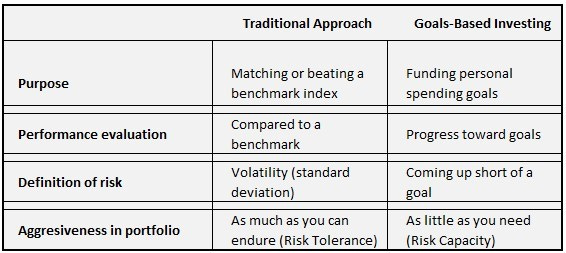Goals-Based Retirement Planning Is All About You
Instead of focusing on arbitrary market returns, in goals-based planning you focus on your personal needs and wants for your financial plan.
Note: This is part two of a three-part series that takes a look at planning for retirement during the “fragile decade” — the five years before you retire plus the first five years of your retirement. Part one is In Retirement Planning, Consider the Entire Journey.
In part one of this series, we discussed how a prolonged downturn in the market during the fragile decade can derail withdrawal plans. The conventional approach to managing through market declines and loss years is to take the long view, keep investing, and rely on long-term averages to eventually help the portfolio recover.
This approach can work well when you are younger and have salary income and decades to ride out the storm before taking withdrawals. For those of us near or in the fragile decade, the long view may not be the optimal course of action, or worse, it could be downright devastating, as we saw in part one.
As you approach your retirement date, you should have a more accurately defined and refined list of spending needs. As a result, this is when your investment strategy can (and likely will) diverge from the accumulation stage.
A lot of the investing concepts we discuss for the accumulation stage (and are put forth by financial advisers) are grounded in Modern Portfolio Theory (MPT), which seeks to optimize market returns and risk by asset class. Simply stated, as you invest for the long term, get as much of a return as you can, given your level of risk tolerance.
Harry Markowitz introduced the world to MPT in 1952, and his principles have influenced generations of financial thinking. In 1990, Markowitz shared the Nobel Memorial Prize in Economic Sciences for his efforts around MPT.
Finding this optimal balance of return and risk is what Markowitz describes as investing along the efficient frontier. MPT has been successfully used for decades by institutions such as endowments, pension plans and large trust funds, etc. The traditional approach to retirement planning has taken the principles of MPT and adapted them to individual investors.
But here’s the rub: Large institutions, like endowments, have an infinite time horizon without a fragile decade. Institutions are effectively in a perpetual accumulation stage. They do not need to plan for and manage through a significant and finite withdrawal stage, but you do.
“If you want something you’ve never had, you must be willing to do something you’ve never done.” — Thomas Jefferson
Enter goals-based planning. With origins going back decades, goals-based planning gained in popularity after the 2008-2009 financial crisis. It seeks to refocus our goals away from obtaining abstract market return rates and toward meeting specific personal goals (e.g., our monthly spending needs).
As such, we should similarly reframe our risk profile, moving away from focusing on the volatility of market prices. We should describe our risk in a much more personal way: Our principal risk is the chance that we fall short of our spending goals.
A goals-based approach to planning can help make the risk more tangible. We take measured, personally defined risks and don’t endlessly ponder esoteric risks (such as standard deviation, alpha, beta, R-squared and the Sharpe ratio). Goals-based planning is focused on optimizing a limited pool of financial assets by matching assets and income with future liabilities and expenses (i.e., future spending needs).
If, for example, you can meet all your cash flow needs with a 5% return, then why take on a greater risk of loss to try to achieve a higher return? Why risk losing what you have and need to chase what you don’t have and don’t need? Learn to be comfortable with having enough.
Your goals, not just your risk tolerance, should drive investing decisions. During the withdrawal stage, income and capital preservation become much more important than stretching for outsized returns.
Under the umbrella of goals-based planning, the idea of a safety-first strategy has evolved. Briefly, a goals-based safety-first strategy looks at your spending goals in two broad buckets. The first, the safe bucket, seeks to cover your basic financial needs (e.g., housing, food, health care, emergency fund, etc.) with assets invested with as little risk as possible (the safety-first component).
Safety-first investments to consider
To start, you might think of safety-first investments such as bank CDs, money market funds, short-duration government bonds and bond ladders, etc. But don’t lose sight of other financial resources you might have beyond cash and bonds that could also provide safety-first withdrawals. For example, Social Security, a pension, rental income from real estate, income annuities, and insurance products. The key is to build a stream of income that will cover your basic needs regardless of a declining stock market.
Once this safety-first basket is secure, you can then put the remainder of your portfolio in the second or aggressive bucket, to cover discretionary spending (wants), which can be invested as aggressively (or conservatively) as you see fit. When your basic needs are met, you can decide how much risk you want to take to achieve your aspirational wants — those items that would be nice to have (more frequent vacations, etc.), but in a falling stock market, you could do without.
In part three of this series, we’ll offer up some specific ideas for mitigating the impact of sequence of returns risk and protecting the retirement cash flow you have diligently worked to achieve.
As always, invest often and wisely. Thank you for reading.
The content is for informational purposes only. It is not intended to be, nor should it be construed as legal, tax, investment, financial, or other advice. It is merely my own random thoughts.
The best way to spread the word about a book you enjoyed is to leave an honest review. Thank you for taking the time to click here and posting your review of Wealth Your Way. Your review will help other readers explore their own path to wealth!







